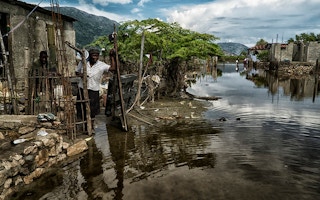What do an Ethiopian coffee grower, a Colombian fisherman and a Vietnamese rice farmer have in common?
All three saw their income and way of life threatened by the devastating El Niño weather pattern in 2015-16, climate experts said at a London event Tuesday.
The last El Niño, a warming of ocean surface temperatures in the eastern and central Pacific that typically occurs every few years, was linked to crop damage, fires and flash floods in 2016.
Although such climate shocks are increasingly frequent and intense, they are no less difficult to forecast, said Michael Morecroft from Natural England, a British public body working to protect nature.
The world is being forced to adapt to “new combinations of climate conditions that we haven’t seen before”, Morecroft said.
“When we’re adapting to climate change, we’re not adapting to a new stable state, we’re adapting to uncertainty,” he told an audience at the Royal Society, a British science institution.
That requires new ways of building resilience in some of the world’s most climate-threatened places, he added, calling for more “nature-based solutions” and partnerships across sectors.
Rosalind West from Britain’s Department for International Development said early action - in part by making funding more flexible - could “help save time, money and lives” when a disaster strikes.
The British government is increasingly investing in forecast-based financing, which involves releasing assistance to communities according to pre-agreed triggers – such as weather predictions – rather than waiting for torrential rains or dry spells to cause havoc, West said.
El Niño disrupted water supplies for 97 per cent of SMEs in Gaborone and power supplies for all SMEs in Lusaka.
Declan Conway, Grantham Research Institute on Climate Change and the Environment, London School of Economics
Carmen Lacambra from Grupo Laera, a Colombian consultancy firm, said that such solutions will only work if they involve local communities in planning and determining priorities.
People in the developing world often feel like “research commodities”, she said.
“They see academic teams visiting them from all over the world, but rarely have a say in the research process and ultimately remain as poor as ever.”
The damage wrought by El Niño is not limited to rural areas, said Declan Conway from the London School of Economics’ Grantham Research Institute on Climate Change and the Environment.
For example, research showed that erratic rainfall in sub-Saharan African cities in 2015-16 caused significant disruption to small and medium-sized enterprises (SMEs), Conway said.
“El Niño disrupted water supplies for 97 percent of SMEs in Gaborone (the capital of Botswana) and power supplies for all SMEs in Lusaka”, the capital of Zambia, he said.
This story was published with permission from Thomson Reuters Foundation, the charitable arm of Thomson Reuters, that covers humanitarian news, women’s rights, trafficking, property rights, climate change and resilience. Visit http://news.trust.org.










